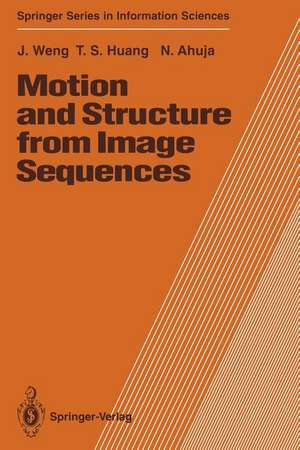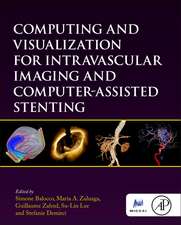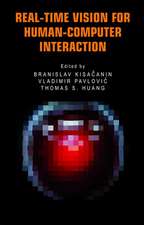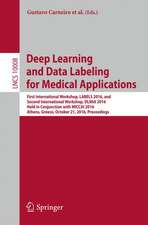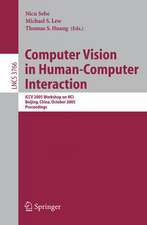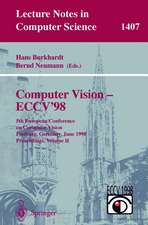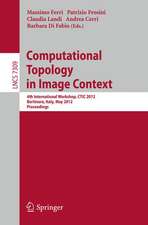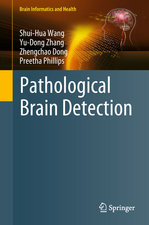Motion and Structure from Image Sequences: Springer Series in Information Sciences, cartea 29
Autor Juyang Weng, Thomas S. Huang, Narendra Ahujaen Limba Engleză Paperback – 8 dec 2011
Din seria Springer Series in Information Sciences
- 20%
 Preț: 337.66 lei
Preț: 337.66 lei - 18%
 Preț: 955.08 lei
Preț: 955.08 lei - 15%
 Preț: 646.62 lei
Preț: 646.62 lei - 20%
 Preț: 337.52 lei
Preț: 337.52 lei -
 Preț: 385.62 lei
Preț: 385.62 lei -
 Preț: 381.98 lei
Preț: 381.98 lei -
 Preț: 391.61 lei
Preț: 391.61 lei - 20%
 Preț: 324.64 lei
Preț: 324.64 lei -
 Preț: 380.84 lei
Preț: 380.84 lei - 18%
 Preț: 777.69 lei
Preț: 777.69 lei -
 Preț: 387.96 lei
Preț: 387.96 lei -
 Preț: 396.62 lei
Preț: 396.62 lei - 20%
 Preț: 330.75 lei
Preț: 330.75 lei -
 Preț: 382.57 lei
Preț: 382.57 lei - 15%
 Preț: 642.18 lei
Preț: 642.18 lei - 15%
 Preț: 640.06 lei
Preț: 640.06 lei -
 Preț: 387.58 lei
Preț: 387.58 lei - 20%
 Preț: 333.40 lei
Preț: 333.40 lei -
 Preț: 386.99 lei
Preț: 386.99 lei - 15%
 Preț: 661.02 lei
Preț: 661.02 lei - 18%
 Preț: 1391.21 lei
Preț: 1391.21 lei - 15%
 Preț: 638.43 lei
Preț: 638.43 lei - 15%
 Preț: 642.68 lei
Preț: 642.68 lei -
 Preț: 386.00 lei
Preț: 386.00 lei - 20%
 Preț: 649.60 lei
Preț: 649.60 lei - 18%
 Preț: 950.21 lei
Preț: 950.21 lei -
 Preț: 393.35 lei
Preț: 393.35 lei - 20%
 Preț: 652.41 lei
Preț: 652.41 lei - 20%
 Preț: 645.65 lei
Preț: 645.65 lei -
 Preț: 390.25 lei
Preț: 390.25 lei -
 Preț: 387.96 lei
Preț: 387.96 lei - 15%
 Preț: 580.97 lei
Preț: 580.97 lei
Preț: 653.71 lei
Preț vechi: 817.14 lei
-20% Nou
Puncte Express: 981
Preț estimativ în valută:
125.09€ • 133.76$ • 104.30£
125.09€ • 133.76$ • 104.30£
Carte tipărită la comandă
Livrare economică 18 aprilie-02 mai
Preluare comenzi: 021 569.72.76
Specificații
ISBN-13: 9783642776458
ISBN-10: 3642776450
Pagini: 464
Ilustrații: XV, 444 p.
Dimensiuni: 155 x 235 x 24 mm
Greutate: 0.64 kg
Ediția:Softcover reprint of the original 1st ed. 1993
Editura: Springer Berlin, Heidelberg
Colecția Springer
Seria Springer Series in Information Sciences
Locul publicării:Berlin, Heidelberg, Germany
ISBN-10: 3642776450
Pagini: 464
Ilustrații: XV, 444 p.
Dimensiuni: 155 x 235 x 24 mm
Greutate: 0.64 kg
Ediția:Softcover reprint of the original 1st ed. 1993
Editura: Springer Berlin, Heidelberg
Colecția Springer
Seria Springer Series in Information Sciences
Locul publicării:Berlin, Heidelberg, Germany
Public țintă
ResearchCuprins
1. Introduction.- 1.1 Formulation of the Problem.- 1.2 Overview of Recent Progress.- 1.3 Bibliographical Notes.- 2. Image Matching.- 2.1 Approaches to Establishing Correspondences.- 2.2 An Approach to Image Matching.- 2.3 Algorithm.- 2.4 Motion and Structure Computation.- 2.5 Refinements.- 2.6 Examples.- 2.7 Summary.- 2.8 Bibliographical Notes.- 3. Two-View Analysis.- 3.1 Some Basic Issues.- 3.2 An Algorithm.- 3.3 Error Estimation.- 3.4 Error Analysis.- 3.5 Performance.- 3.6 Summary.- 3.7 Bibliographical Notes.- Appendix 3.A Perturbation of Eigenspace.- Appendix 3.B Quaternions.- Appendix 3.C Alternative Fitting.- 4. Optimization.- 4.1 Motivations.- 4.2 Stability of Linear Algorithms.- 4.3 Maximum Likelihood Estimation.- 4.4 A Two-Step Approach and Computation.- 4.5 Minimum Variance Estimation.- 4.6 Error Estimation and Error Bounds.- 4.7 Batch and Sequential Methods.- 4.9 Summary.- 4.10 Bibliographical Notes.- Appendix 4.A Decomposability.- Appendix 4.B Weights.- Appendix 4.C Triangulation with Noise.- Appendix 4.D Matrix Derivatives.- Appendix 4.E Cramér-Rao Bound.- 5. Planar Scenes.- 5.1 Planar Scene as a Degenerate Case.- 5.2 Motion from a Plane.- 5.3 Inherent Uniqueness.- 5.4 Examples.- 5.5 Conclusions.- 5.6 Bibliographical Notes.- Appendix 5.A Conditions on the Rank of A.- Appendix 5.B Two Solutions from F.- Appendix 5.C Plane-Perceivable Surfaces.- Appendix 5.D Condition on Consistent Normals.- Appendix 5.E Two-View Algorithm.- Appendix 5.F Error Estimation.- 6. From Line Correspondences.- 6.1 Lines as Features.- 6.2 Solution and Algorithm.- 6.3 Degeneracy.- 6.4 Optimization.- 6.5 Simulations.- 6.6 Conclusions and Discussions.- 6.7 Bibliographical Notes.- Appendix 6.A Ranks.- Appendix 6.B Unique Consistent Assignment.- Appendix 6.C Degeneracy.- Appendix 6.DDistinct Locations Are Necessary.- Appendix 6.E Alternative Degeneracy Condition.- 7. Stereo.- 7.1 Stereo Camera Systems.- 7.2 Stereo Triangulation.- 7.3 Closed-Form Solution.- 7.4 Iterative Optimal Solution.- 7.5 Outliers and Robust Estimators.- 7.6 Examples.- 7.7 Without Stereo Correspondences.- 7.8 Long Image Sequences.- 7.9 Conclusions.- 7.10 Bibliographical Notes.- Appendix 7.A MWCC Theorem.- Appendix 7.B Least-Squares Matrix Fitting.- 8. Motion Modeling and Prediction.- 8.1 Coherence of Motion.- 8.2 The LCAM Model.- 8.3 Estimation and Prediction.- 8.4 Monocular Vision.- 8.5 Optimization.- 8.6 Experimental Examples.- 8.7 Summary.- 8.8 Bibliographical Notes.- Appendix 8.A Solution of Coefficient Equations.- Appendix 8.B Rotation without Precession.- Appendix 8.C Singularity of the Matrix.- References.
